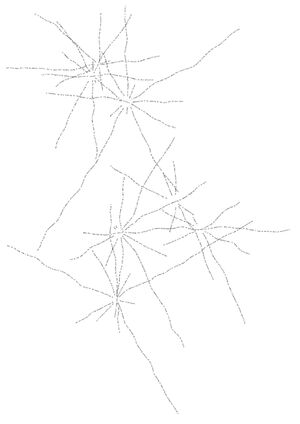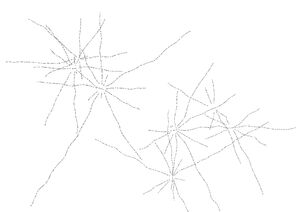Mycelines: A Sympoetic Imagination
A Myceline (a neologism made up of ‘mycelium’ and ‘line') is a “line” of text that grows like a mycelium. Mycelines can be generated based on a word-in-context analysis of one piece or multiple pieces of text. A shared word between two sentences has the potential to become a “node,” enabling new mycelines to grow from it. It breaks the linear, one-directional flow of the written language and demonstrates how interconnected our language is with new visual representations and evolving textual behaviors. In Staying with the Trouble[1], Donna J. Haraway introduced the term sympoiesis based on autopoiesis, Sympoiesis means “making-with”, or “collectively-producing systems that do not have self-defined spatial or temporal boundaries. Information and control are distributed among components. The systems are evolutionary and have the potential for surprising change.” By contrast, autopoietic systems are “self-producing” autonomous units “with self defined spatial or temporal boundaries that tend to be centrally controlled, homeostatic, and predictable.”
If we apply this way of thinking to words and text, to think about autopoietic as auto-poetics, auto-poetic can then be used to describe generative textual systems with centrally defined generative rules, while sym-poetic are for texts that are collectively produced among various dynamic components. Mycelines are created with sympoetic in mind. Here, words decide how they organize themselves spatially based on the flow of each sentence instead of following one predefined direction, allowing concepts and thoughts interact and merge in a process akin to anastomosis in fungal networks.
The Code below shows the process of word in context analysis of the text “Re-, Un-, Defining Tools” by the Feminist Search Tools working group. We can see that words such as “tool”, “think”, “conversation” and “process” are mentioned the most, which make them important nodes in the generated myceline network.
- Qianxun Chen is a media artist, programmer and researcher. She works at the intersection of art, technology and language, with a focus on generative poetics, the aesthetics of algorithm and digital textuality. Her works tend to bring up artistic and non-human perspectives of the world through alternative usage of technology.
Concorder = class
conversationText = FileAttachment {
- name: "conversation.txt"
- mimeType: "text/plain"
- <prototype>: FileAttachment {}
}
ct = await conversationText.text()
concordance = new Concorder(text, {
- ignoreCase: true,
- ignoreStopWords: true,
- ignorePunctuation: true,
- isSentenceLevel : true
});
cAnalysis = getAnalysis(concordance)
cAnalysis = Object {
- tool: Array(67)
- think: Array(18)
- tools: Array(15)
- conversation: Array(18)
- something: Array(16)
- process: Array(16)
- library: Array(10)
- digital: Array(14)
- project: Array(13)
- way: Array(12)
- different: Array(9)
- make: Array(11)
- gender: Array(8)
- part: Array(10)
- through: Array(8)
- search: Array(9)
- find: Array(7)
- catalog: Array(8)
- question: Array(8)
- … more
}

